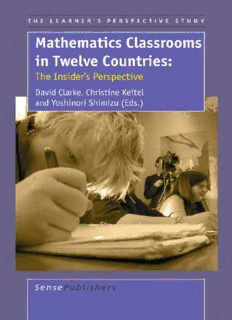
Mathematics Classrooms in Twelve Countries: The Insider's Perspective PDF
Preview Mathematics Classrooms in Twelve Countries: The Insider's Perspective
Mathematics Classrooms in Twelve Countries Mathematics Classrooms in Twelve Countries The Insider’s Perspective Edited by David Clarke Christine Keitel Yoshinori Shimizu University of Melbourne Freie Universität Berlin University of Tsukuba Australia Germany Japan SENSE PUBLISHERS ROTTERDAM / TAIPEI A C.I.P. record for this book is available from the Library of Congress. ISBN 90-77874-95-X (paperback) ISBN 90-77874-99-2 (hardback) Published by: Sense Publishers, P.O. Box 21858, 3001 AW Rotterdam, The Netherlands http://www.sensepublishers.com Printed on acid-free paper Cover design: Cameron Mitchell, ICCR, Melbourne, Australia Cover Photo: Simulated data generation at Flinders Peak Secondary College, Corio, Victoria, Australia, Used with Permission All Rights Reserved © 2006 Sense Publishers No part of this work may be reproduced, stored in a retrieval system, or transmitted in any form or by any means, electronic, mechanical, photocopying, microfilming, recording or otherwise, without written permission from the Publisher, with the exception of any material supplied specifically for the purpose of being entered and executed on a computer system, for exclusive use by the purchaser of the work. SERIES PREFACE The Learner’s Perspective Study provides a vehicle for the work of an international community of classroom researchers. The work of this community will be reported in a series of books of which this is the first. The documentation of the practices of classrooms in other countries causes us to question and revise our assumptions about our own practice and the theories on which that practice is based. International comparative and cross-cultural research has the capacity to inform practice, shape policy and develop theory at a level commensurate with regional, national or global priorities. International comparative research offers us more than insights into the novel, interesting and adaptable practices employed in other school systems. It also offers us insights into the strange, invisible, and unquestioned routines and rituals of our own school system and our own classrooms. In addition, a cross-cultural perspective on classrooms can help us identify common values and shared assumptions, encouraging the adaptation of practices from one classroom for use in a different cultural setting. As these findings become more widely available, they will be increasingly utilised in the professional development of teachers and in the development of new theory. David Clarke Series Editor TABLE OF CONTENTS Acknowledgements xi 1 The Learner’s Perspective Study 1 David Clarke, Christine Keitel and Yoshinori Shimizu 2 The LPS Research Design 15 David Clarke 3 ‘Setting a Task’ in German Schools: Different Frames for Different Ambitions 37 Christine Keitel 4 The Role of Seatwork in Three Japanese Classrooms 59 Keiko Hino 5 Mathematics Education Reform in Three US Classrooms 75 Terry Wood, Soo Yeon Shin and Phu Doan 6 Teacher-Dominating Lessons in Shanghai: The Insiders’ Story 87 Ida Ah Chee Mok 7 Mathematics Teaching in Two Singapore Classrooms: The Role of the Textbook and Homework 99 Berinderjeet Kaur, Low Hooi Kiam and Seah Lay Hoon 8 Fine-Tuning a Language of Description for Mathematics Items which Incorporate the Everyday 117 Godfrey Sethole, Busi Goba, Jill Adler and Renuka Vithal 9 ‘Ganas’ – A Motivational Strategy: Its Influence on Learners 131 Soledad Asuncion Ulep 10 Case Studies of Singapore Secondary Mathematics Classrooms: The Instructional Approaches of Two Teachers 151 Seah Lay Hoon, Berinderjeet Kaur and Low Hooi Kiam 11 Students’ Verbal Actions in German Mathematics Classes 167 Astrid Begehr 12 Discrepancies in Perceptions of Mathematics Lessons Between the Teacher and the Students in a Japanese Classroom 183 Yoshinori Shimizu vii 13 Students’ Private Discourse in a Philippine Classroom: An Alternative to the Teacher’s Classroom Discourse? 195 Florenda Lota Gallos 14 The Israeli Classroom: A Meeting Place for Dichotomies 209 Michael N. Fried and Miriam Amit 15 Autonomous Looking-In to Support Creative Mathematical Thinking: Capitalising on Activity in Australian LPS Classrooms 221 Gaye Williams 16 A Tale of Two Cities: A Comparison of Six Teachers in Hong Kong and Shanghai 237 Ida Ah Chee Mok and Francis Lopez-Real 17 Mathematics Lessons in Korea: Teaching with Systematic Variation 247 Kyungmee Park and Frederick Koon Shing Leung 18 Repetition or Variation: Practising in the Mathematics Classroom in China 263 Rongjin Huang, Ida Ah Chee Mok and Frederick Koon Shing Leung 19 Constitution of the Classroom Environment: A Case Study 275 Helena Binterová, Alena Ho"pesová and Jarmila Novotná 20 Mathematical Norms in Japanese Mathematics Lessons 289 Yasuhiro Sekiguchi 21 Same from the Outside, Different on the Inside: Swedish 307 Mathematics Classrooms from Students’ Points of View Jonas Emanuelsson and Fritjof Sahlström Appendix A: Country Overviews Introduction 323 Christine Keitel Australia 327 Gaye Williams, Carmel Mesiti and David Clarke China 331 Frederick Koon Shing Leung, Ida Ah Chee Mok and Rongjin Huang viii Czech Republic 335 Jarmila Novotná Germany 339 Christine Keitel and Eva Jablonka Israel 345 Miriam Amit and Michael N. Fried Japan 349 Yoshinori Shimizu Korea 353 Kyungmee Park The Philippines 357 Florenda Lota Gallos and Soledad Asuncion Ulep Singapore 361 Berinderjeet Kaur South Africa 365 Jill Adler, Busi Goba, Renuka Vithal, Godfrey Sethole Sweden 369 Sverker Lindblad The United States of America 373 Terry Wood Author Index 377 Subject Index 385 ix
Description: